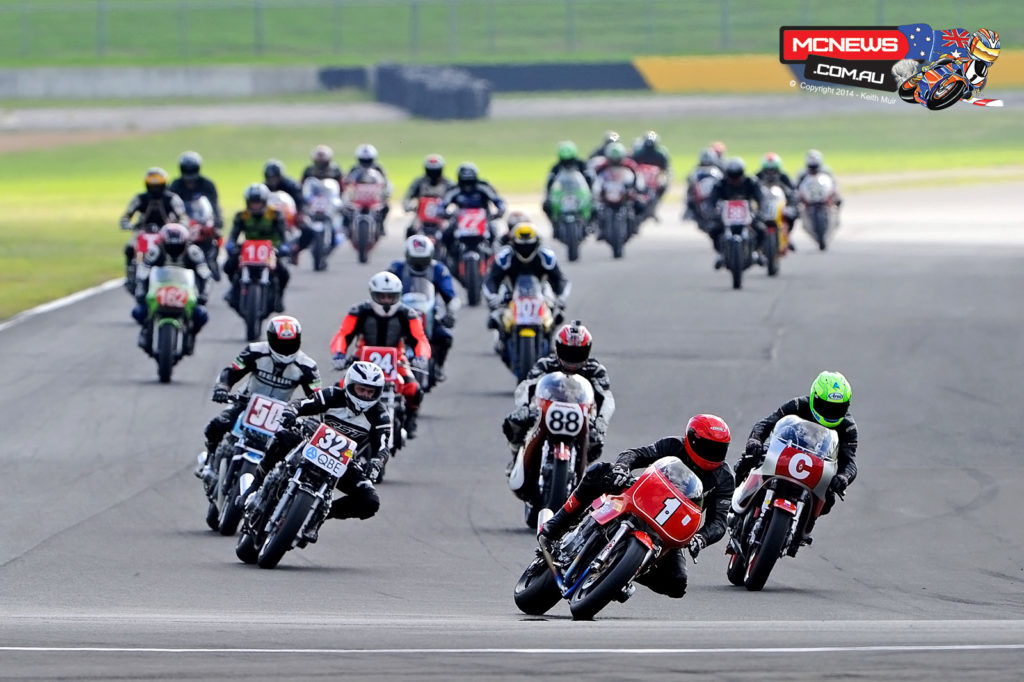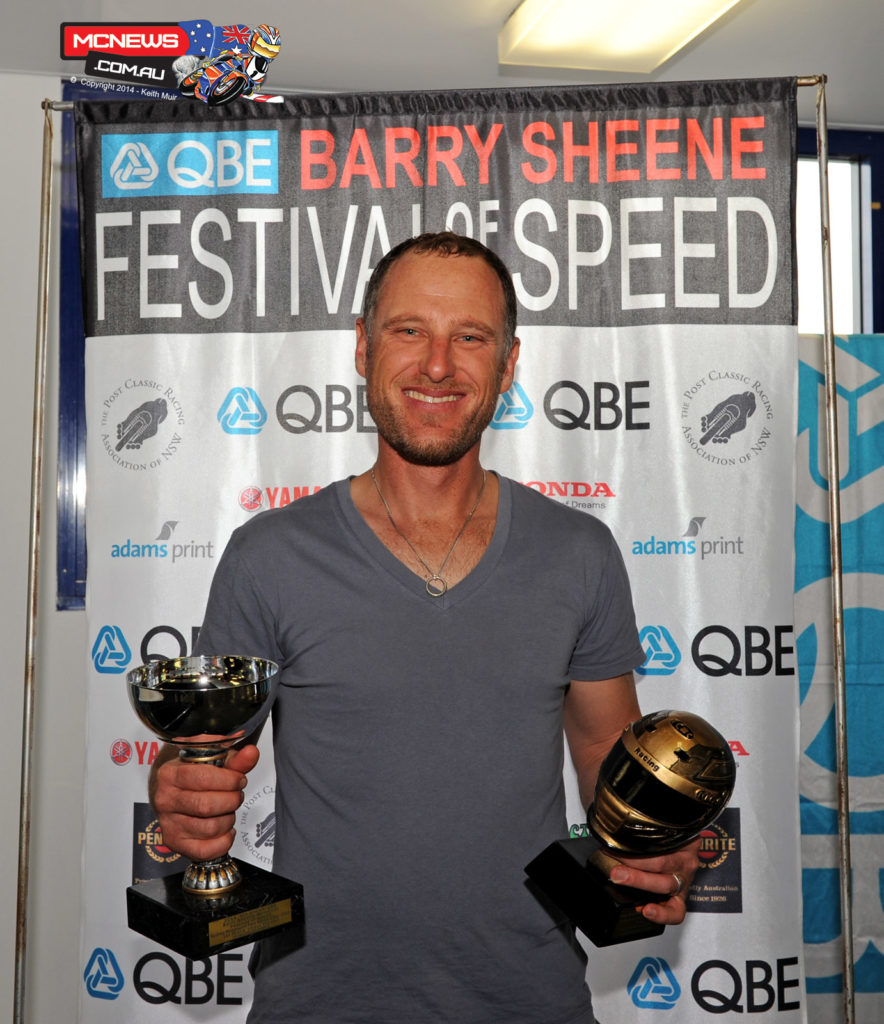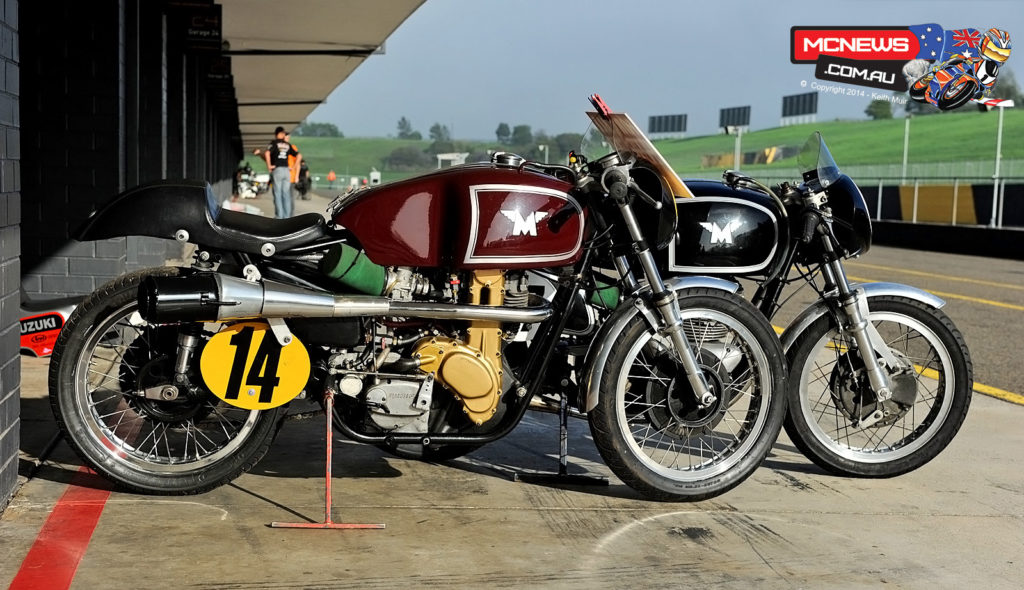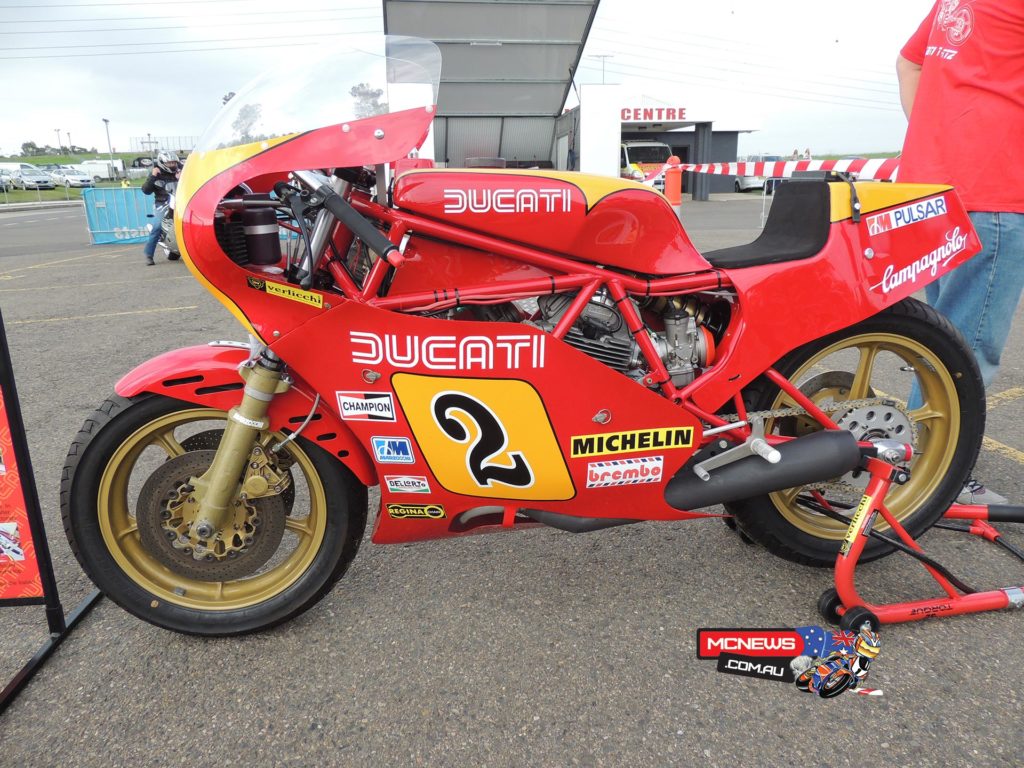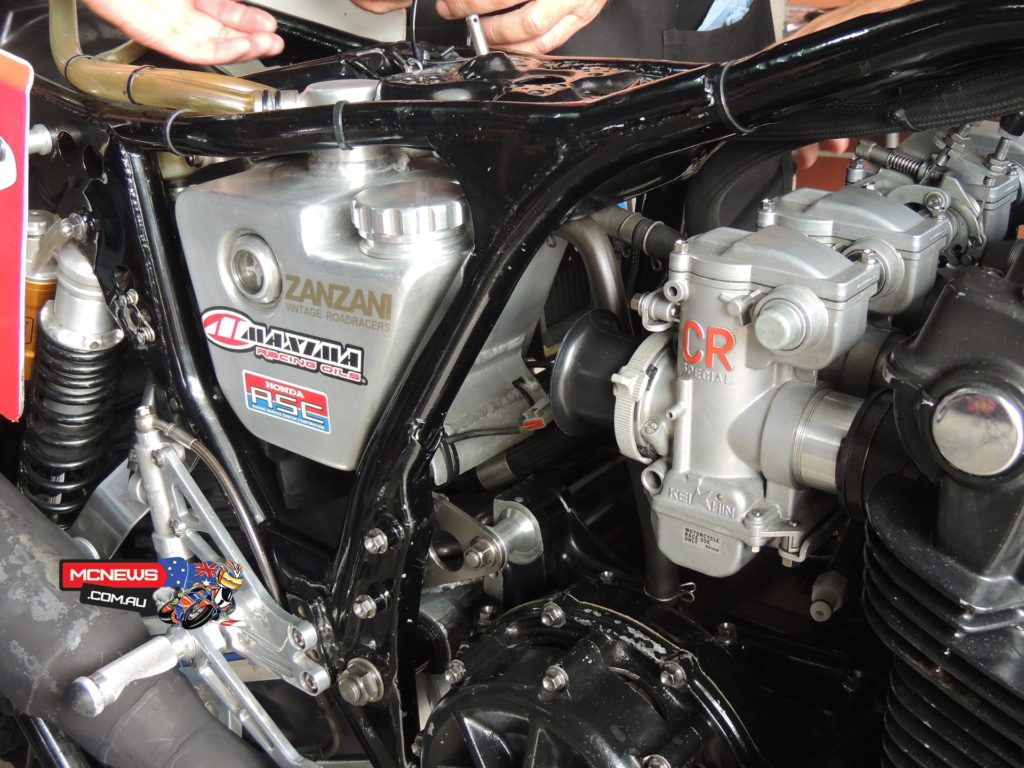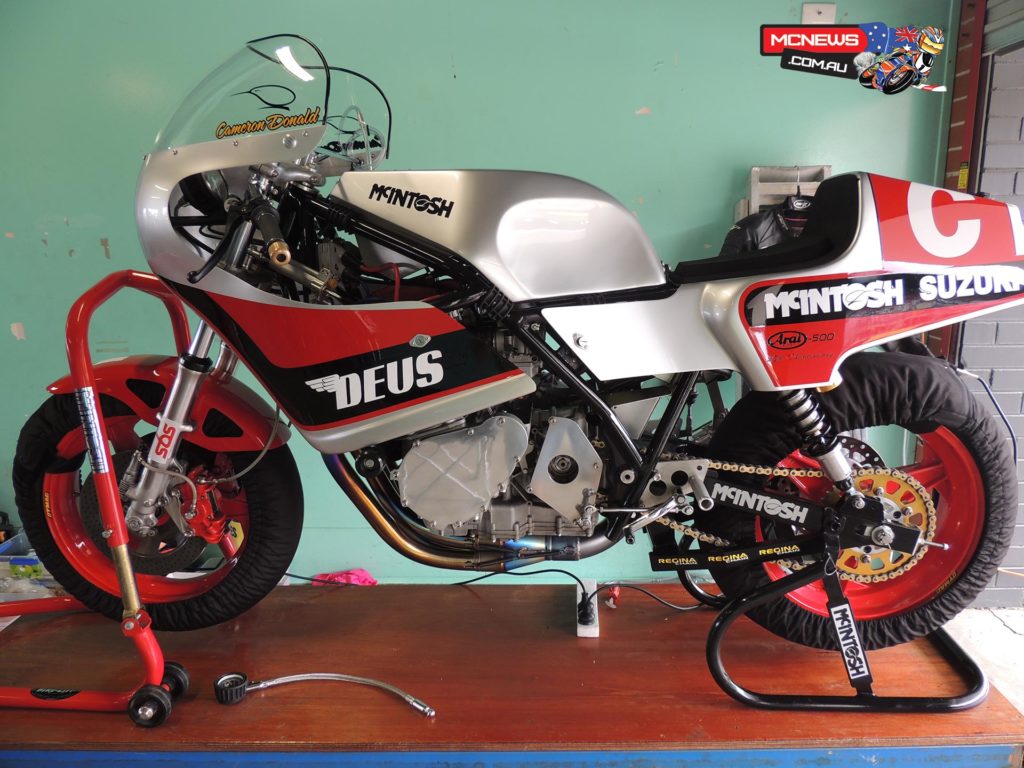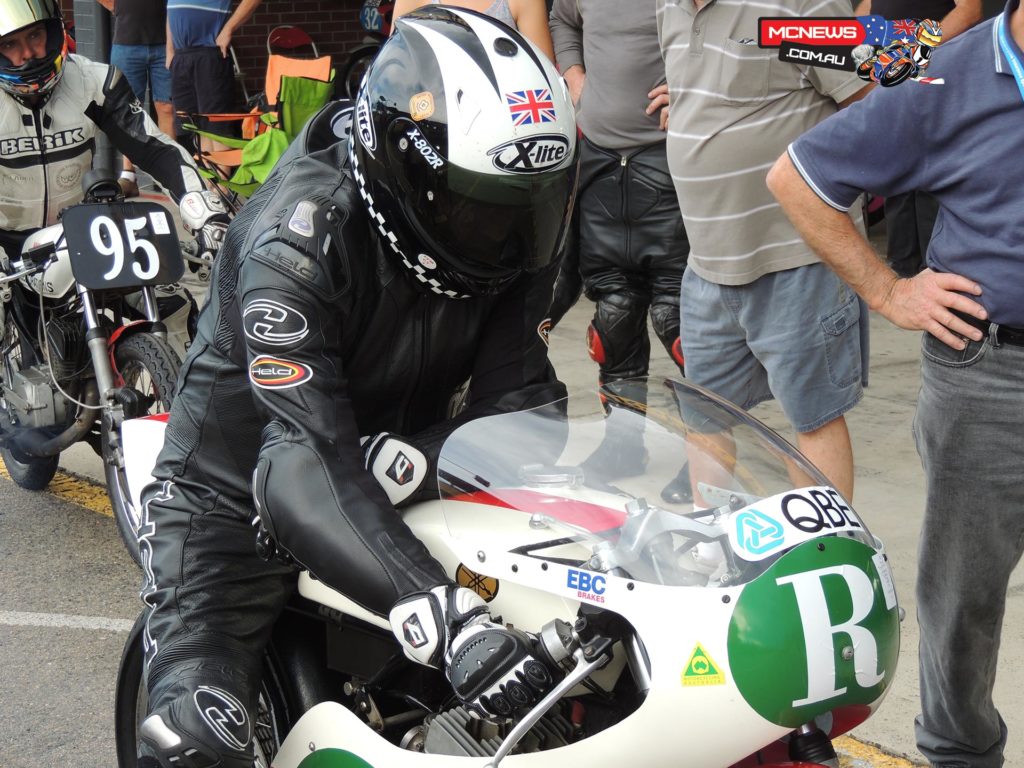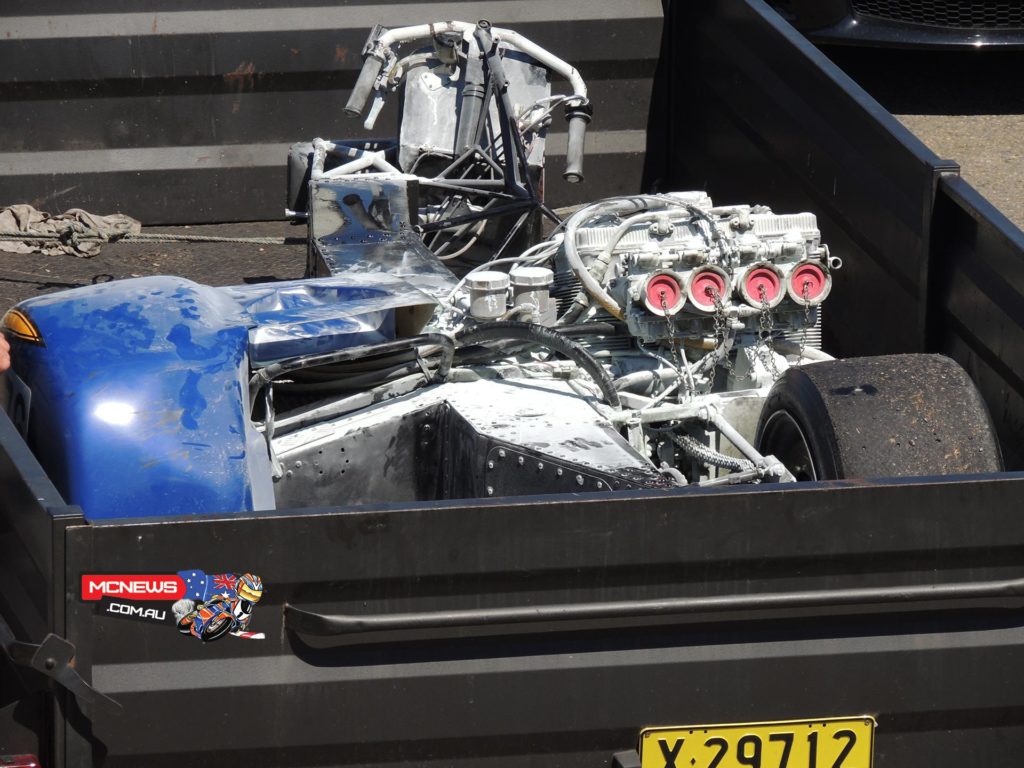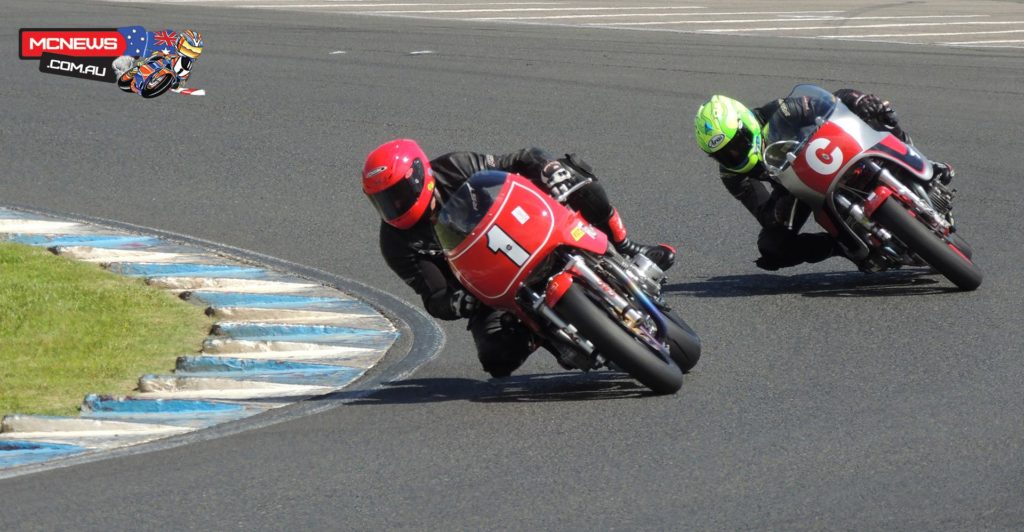Stars shine at the Sheene – By Phil Hall
This weekend saw the 9th running of the annual Barry Sheene Festival of Speed at Sydney Motorsport Park (Eastern Creek Raceway). As always it attracted a huge number of competitors who love the competition and the camaraderie that have become traditional with historic racing events in Australia.
Along with the “usual suspects” there were some imported stars as well. 8 times World Champion, Phil Read, from the UK, was the Guest of Honour and also competed in a number of events, albeit on borrowed machinery and with borrowed racing gear that did not always suit him. Being the revered champion that he is and being 75 years old as he is, nobody was expecting anything more than the thrill of seeing one of the legends of the sport out on the track, so it didn’t really matter.
Read has been making a number of these guest appearances over the last few years at high profile meetings like Classic Spa so it was a real coup for the PCRA to secure his attendance at the Sheene. Of course his remembrances of the great Barry Sheene were also sought and he spoke at length about riding in the bad old days where a number of riders used to be killed every year on the narrow and dangerous tracks on which GPs were contested back in the 60’s and 70’s. Read was accessible, charming and witty and he certainly enjoyed the weekend and the laid-back nature of it.
The two other notable visitors were British lady rider, Maria Costello MBE and New Zealand teenager, Scout Fletcher. Like Read they were competing on borrowed machinery and did so with varying degrees of success. Fletcher had the services of Ken Lindsay’s 125 Grand Prix bike while Costello had a P6 VFR400 at her disposal (Rob Francis’s bike) as well as a 125 GP bike (Stephen Kairl) and a Manx Norton (Mick Neason.)
These two personable and talented ladies livened up proceedings no end and both expressed a desire to come back to Australia and race again, Costello appearing to be very interested in the prospect of a trip to the Island Classic as part of Team GB in 2015.
As well, as the Trans Tasman Challenge was an important part of the weekend, a strong contingent of New Zealand riders were on hand, many of whom had shipped their machinery across the Tasman to be there, a huge commitment. In order to make the challenge fair, however, some Australian riders were “lent” to the NZ team, the most notable of these being Aussie international, Cam Donald. Donald had the availability of a superb machine to ride as well. Legendary NZ engineer, Ken Macintosh, was there to fettle a superb Suzuki-engined Macintosh-framed race bike and what a magnificent piece of work it was. The bike was billed as the “Three Cam Macintosh” – 2 cams by Suzuki and one by Donald. Very clever.
Donald did not have it all his own way, however in the Period 5 Unlimited category. He faced a stern challenge for overall honours from Melbourne’s Michael Dibb on the Harris-framed Honda out of the T Rex stable. Dibb was outstanding, taking the overall points win in the category over Donald by a mere three points after 5 rounds, three wins to Dibb and two to Donald. Understandably, their races were the highlight of the weekend with the lead constantly changing throughout and the races decided by minute amounts of time and distance on the line. By the time the final race in the category rolled around, Donald had gained the measure of his opponent and won the last race convincingly. Watching these two champions balancing on the razor’s edge in their powerful superbikes was worth the cost of admission by itself.
Victoria’s Peter Mizzi rounded out the top three for the weekend with some solid finishes in the P5 races and he was followed home by Japanese rider, Tomoki Adachi on his Kawasaki. Adachi and his fellow Japanese rider, Yuji Terada, had been brought out to the meeting by Old Gold Motorcycle’s Steve Leembruggen and it made a fascinating scene in the pits. Unable to speak English at all, there was much bowing and smiling and good humour as the punters admired Adachi’s beautiful Kawasaki and Terada’s equally amazing Suzuki Katana. Crammed full of the latest Japanese go-faster bits, the bikes would have been at home in a concours rather than at a race track.
Adachi took some time to get used to the track but soon found his inner banzai and started showing some real riding skills. Terada struggled all weekend, however, and looked decidedly “out of sorts” The language barrier, unfortunately prevented me from interviewing the riders and getting their impressions. As his confidence grew, Adachi started to get near the front but, unfortunately, his radical riding style ruffled a few feathers (and a few bikes) before the meeting was over.
Perennial favourite, Robbie Phillis, was there but not on the familiar Katana. Preparation earlier in the week had revealed a major engine problem that had occurred at the WSBK meet a few weeks ago. So, it was down to Plan B. Robbing the clutch and the ignition off the Katana (that had previously been robbed off the old bike anyway) Robbie and Roger resurrected “The Old Girl”, Robbie’s 1981 GSX1100 Suzuki, on which he won the first of his four consecutive Australian Superbike Championships. Not having ridden the bike for over four years and knowing that the motor was well down on horsepower compared to the #1 bike, Robbie was very laid-back, soaking up the atmosphere, entertaining all and sundry with his constant supply of outrageous stories and generally being Robbie Phillis. Come race time, however, the jokes evaporated and Robbie set out to make up for lack of horsepower with riding prowess.
In the end, three third placings and two DNS’s garnered Australia’s favourite racer 5th place on points for the meeting.
Of the rest, the standout performer was NSW’s Steve Dobson. On his built-at-home cheap and cheerful Kawaskai Z1R, Dobson finished in or near the top ten in all five races against machinery that cost a great deal more to build than his bike had. For a rider who has only been racing for two and a half years, Dobson is the stand-out example of why this class is so popular.
It must also be said that, were it not for an exclusion from Race 4 due to an oversized tyre (WSBK support races allowed a 190 rear, PCRA requires a 180 and the wrong tyre was put on for the race) and a DNS in Race 5, Glenn Hindle would have finished much further up in the points than what he did. Consistently in the top 4 for the first three races, Hindle was outstanding on the unfancied Suzuki and certainly showed that it isn’t how much money you spend on your bike, as much as it is how much talent you can put behind the handlebars that matters.
Period 4 Unlimited should have belonged to Dean Oughtred on the Dick Mann replica Honda 750 as he won two of the 5 races. But a DNF in Race 4 allowed New Zealand’s Terry Martin on a Triumph 850 to scoop up the class, finishing 10 points to the better despite only winning one race. The value of consistency. Third in the overall points was Steve Wood on the #38 Honda 1000.
Unsurprisingly, Period 4 750 belonged to the booming Ducati of Qld’s Bob Garner, winning four races and finishing second in the other, the others were left pretty much floundering. Dave Mason on another Ducati finished second, 16 points adrift with third going to the TZ750-mounted NSW rider, Terry McKinnon.
All categories, and especially the more modern ones, were well represented with Period 6 being crammed with some highly desirable machinery, some of which would still be quite at home and quite competent on the street. P6 750 was won by Steve Anderson with Stuart Lomax and Rick Kwok filling the minors, all on GSXR Suzukis.
P6 Unlimited was won by Rob Cole, another rider who makes up for lack of “trick” in the bike with exceptional riding skills. Second was the beautifully-prepared Yamaha 1000 of Nige Taylor. If ever a bike deserves to win on looks, it is the Marlboro bike. However, Nige struggled with a carburetion problem right through the weekend and was very frustrated that the bike simply wouldn’t rev out. He did well to secure second overall given the circumstances. Third in the class was Wollongong’s Steve Kairl. A rider who we have been used to seeing in the smaller classes, riding 125’s and 350’s, Kairl was offered a guest ride on Craig Stewart’s FZR1000 (Craig is still recovering from a serious “off”) and he made the most of the opportunity, adapting seamlessly to the bigger bike and showing a distinct liking for having an over-supply of horsepower.
Pre-Modern F1 was won by another favourite rider of mine, Newcastle’s Stephen Ward. On a Suzuki 750, Ward almost rode the programme, winning every race except the first one. He finished 9 points ahead of Queensland’s Brad Phelan who had a win and 4 seconds and David Gileyat (Kawasaki 750).
Pre-Modern F2 Was won by Jonothan Howie (Honda 600) ahead of Ian Phillipson (Yamaha 600) and Nathan Holt (Honda 600, all riders from NSW.
The Australian F1 Sidecar Chanpionship was held as part of the meeting and saw some enthralling sidecar action. The sight of a full field of sidecars all funnelling down into T1 at full noise is something that never loses its excitement or its sense of fear. Hard luck story of the weekend was the Dingley/Dingley team whose outfit caught fire in Race 1 after a fuel line came loose. It was a scary moment or two as they coasted around with fire pouring out of the back of the outfit till they reached the next marshall point where a fire extinguisher was produced and fire was doused. Unfortunately, their weekend was over almost before it had begun.
Lovell/Simonsen won the first two races and looked to have a handle on it but the outfit lurched off the start line (from pole position) in Race 3 and ambled around to the main straight where it was retired. In their absence, the James brothers took the overall win on points, winning the category by 9 points over Pym/Gay and Sayers/Voltic some 8 points further adrift.
Formula 2 sidecars were also contesting round 1 of their championship, the category divided again into Modern, Period 4 and Period 5. The modern machines are very fast and the sound of their 600cc engines being revved as high as the riders dare on the main straight is quite a thrill. The Beare Boys in their immaculate “wood grain” outfit won the class ahead of Rayner/Cumming and West/West. If you looked at the results and saw that the Beare team won all three races you might be tempted to think that it was easy, but the lead changes and the swapping of positions within these races was as exciting as any sidecar race you would want to see.
P4 Sidecars had only one entry, Reilly/Hollingshead and P5 was won by Chivas and McKinnon who scored top points in every round to win from Poucher/Poucher and Hirst/Justice.
The sidecars also took part in the Trans-Tasman Challenge with races for F1 and F2 sidecars. Lovell/Simonsen made up for the disappointment in the Australian F1 Championship round by winning the challenge from Brown/Longhurst and Joyce/Blackman while in the F2 class, Beare/Beare won again from West/West and Rayner/Cumming. P4 saw Reilly/Hollingshead win the class uncontested by any others and P5 went to Chivas/McKinnon, Poucher/Poucher and Selke/Cornwell.
Period 3 250cc saw all entries get on the podium! Johnathan Houston on the delightful little Motob 250 swept the class with three wins ahead of Graeme Osborne (Qld) and John Imrie.
P3 350cc was Philip Paton’s preserve, winning all three races on his Bultaco ahead of Chris Hyland (NZ) and John Kelsey
P4 250 was won by Team Witness Protection’s Peter Wade (love this team) from NSW’s David Miller and Phil Read. Read had 3 DNS’s but boosted his score with two 2nd placings.
P5 125 was Stephen Kairl’s territory, winning all 5 races for a perfect score. Kairl won from Brett Kelly and Terry Morris.
In similar fashion to Kairl, the P5 250 was a clean sweep for Derek Brown, winning all five races to defeat Roger Ward and Andrew Denny, all three placegetters being from NSW.
Jason Dunn scored three wins and two seconds in the highly contested P6 125cc class, Winning the class from Leanne Nelson and the Kiwi teenager, Scout Fletcher who took a second and 4 third placings. Both the lady races harried Dunn all day and the margins of victory were always close.
P6 250cc was the domain of the Johnston brothers from the north coast of NSW. Their distinctive yellow bikes were always at the forefront and the honours eventually went to Mick, who won all five races, from Alan who finished second in all five races and PCRA stalwart, Lech Budniak in 3rd on points.
Tony Roberts on his sky blue RGV Suzuki won the P6 250cc Production ahead of Baden Jones and Ryan Young while RB Performance’s Harley Borkowski swept the Pre Modern F3 on his Honda 400 winning all five races. Second in class was Vito Maniscalco and third was Mitch Kaveny on his Honda 125.
This not to say that the newer bikes provided all the entertainment, far from it. P3 500cc saw New Zealand’s Chris Swallow win all five races on his ES2 Norton, the immaculate black bike being superior to the rest by a fair margin. Laurie Turnbull (Norton) finished second in class and Tony Glazebrook (Norton) was third.
P3 Unlimited only had three entrants and the placings went to Dave Woolsey, Bob Sayer and Ken Lucas.
Period 4 350 was again a clean sweep with second generation racer, Glenn Hindle winning all five legs on the Maxton/Yamaha. Gary Ellem from Queensland was 2nd overall and Tim Britliffe was third.
Period 4 500 was won by Bob Marriner on his Honda 500/4 ahead of TWP’s Peter Wade and Chris Pickett. Marriner won all five races.
Period 5 also was filled with close and exciting racing. For punters like me whose first road racing experiences were in the mid 70’s, this is the category that most reminds me of those halcyon days. The air is filled with the fragrant aroma of two-stroke fumes and the racing is furious.
In P5 the talented Glenn Hindle won all five legs again, beating Derek Brown who scored five second placings and Grant Boxhall. Watching Hindle on this old bike can’t help but remind one of the exploits of his late father whose style Glenn so closely follows.
P3 500cc was Ducati territory with first and second placings in class going to Pantahs. First was Mitchell Mulligan, second was Troy Loveday and third was the Suzuki 500 of New Zealand’s John Cater.
P6 500 was won by Lyall Komuracairns, from Michael McLean and Mark Boddy.
Period 4 750 was won by Ivan Hoey from NSW even though he didn’t win a race. Second place man, Aiden Coote, from WA, won 4 races but DNF’d in the last round to hand Hoey the class win by just 8 points while Paul Coughlan on the beautiful Norton 750 rounded out the podium in this class.
The Ken Lucas Trophy, for rider/bike combination of ages over 90 years was won by Bob Marriner on the Honda 500/4 ahead of Dave Mason on a Ducati 750 and Russell Fairburn on a TZ350 Yamaha.
The last event of the weekend was the Ken Wootton Trophy and it was more than just a little disappointing to see only 8 P4 bikes on the grid for this important race. Nevertheless, the race went ahead and was won in comprehensive fashion by Dean Oughtred on the Honda ahead of Terry Martin (NZ) on his Triumph with Corey Forde in third.
As usual, the meeting was filled with drama, excitement and, perversely, laid-back enjoyment. Yes, the racing was intense, but the intensity was tinged with the sort of atmosphere that only historic racing acn provide. The paddock was filled with happy people, the trade displays were varied and interesting and the Show and Shine was superb, just like we have come to expect.
It was largely an incident-free meeting as well, which is always a blessing. Kiwi Racer Brian Deadman had to be airlifted late on Saturday afternoon after a big one in T1 but subsequent bulletins indicate that his condition is not as bad as was first thought. As usual, the marshalls worked tirelessly in some pretty hot conditions for all three days and the general feel of friendliness and having fun pervaded it all.
“The Sheene” continues to provide a fitting reminder of the fun and frolic for whom it is named and shows every sign of continuing to do so.

